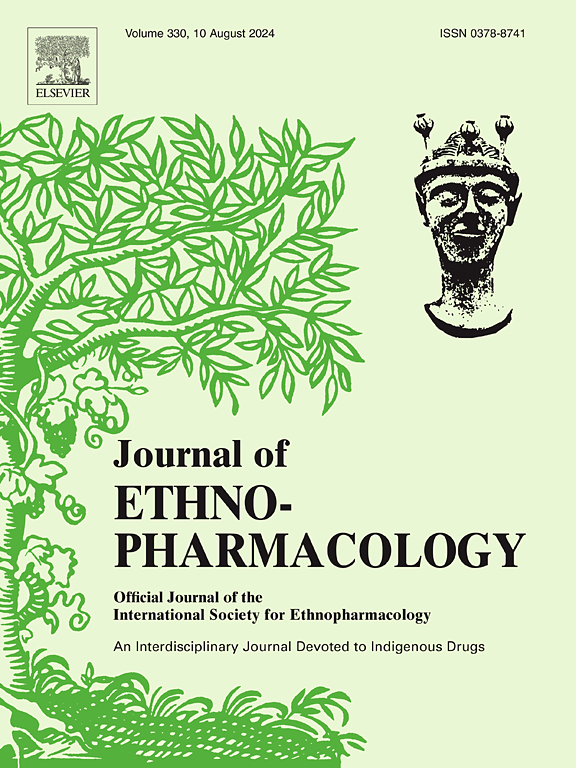对辛弗林通过AMPK/ nf - κ B通路调节肝-脂肪轴改善非酒精性脂肪肝
IF 4.8
2区 医学
Q1 CHEMISTRY, MEDICINAL
引用次数: 0
摘要
金柑的民族药理学意义。是一种民间药物和膳食补充剂,广泛用于缓解因食物潴留和肥胖引起的消化不良。对辛弗林是柑桔中主要的原生物碱。由于它的许多好处,特别是它有可能改善肥胖,因此被广泛使用。我们之前的研究表明,对辛弗林有可能缓解高脂肪饮食(HFD)引起的胰岛素抵抗(IR)和肝脏脂质积累,以及脂肪组织细胞的扩大。然而,对辛弗林在改善非酒精性脂肪性肝病(NAFLD)中的作用尚不清楚。目的探讨对辛弗林对hfd诱导的NAFLD的作用及其机制。方法采用HFD饲养法培养snafld小鼠,每天1次给予对辛弗林治疗,连续21周。采用OGTT、ITT、生化指标测定、H&;E、免疫荧光、天狼星红染色、油红O染色、免疫组织化学、RT-qPCR、Western blot、网络药理学、分子对接等方法评价对辛弗林对NAFLD的保护作用及其机制。结果网络药理学结果提示AMPK-α1可能是对辛弗林缓解NAFLD的核心靶点,AMPK和胰岛素信号通路可能是对辛弗林的关键调控通路。分子对接证实AMPK-α1可能是直接的分子靶点。对辛弗林显著降低了hfd引起的身体、肝脏和iWAT的体重增加。改善糖耐量、胰岛素耐量和HFD引起的脂质代谢紊乱。抑制NAFLD小鼠血清NO、TNF-α、IL-6水平。血清及肝脏中AST、ALT、HYP水平均受到抑制。形态学观察显示对辛弗林减轻了肝脂肪变性和肝纤维化。对辛弗林还显著抑制肝脏新生脂肪生成(DNL),这可以通过调节非酯化脂肪酸(NEFA)和TG含量,以及SREBP-1c、FASN和ACC1 mRNA表达水平来证明。对辛弗林还能逆转hfd诱导的iWAT组织病理变化,通过增加UCP1和PGC-1α的表达促进iWAT褐变。同时,对辛弗林干预显著提高了iWAT和肝脏中IRS-1、PI3K和Akt的磷酸化水平以及GLUT-4的蛋白表达。对辛弗林可降低iWAT和肝脏组织中TNF-α、IL-6、IL-1β的表达及NF-κB的活化。进一步的实验表明,对辛弗林干预能有效调节小鼠iWAT和肝脏的AMPK通路。结论本研究提示对辛弗林可能通过AMPK/NF-κB通路调节肝脂肪轴,从而改善hfd诱导的NAFLD。本文章由计算机程序翻译,如有差异,请以英文原文为准。

p-Synephrine ameliorates non-alcoholic fatty liver disease by regulating liver-adipose axis via AMPK/NF-kappa B pathway
Ethnopharmacological relevance
Citrus aurantium L. var. amara Engl. is a folk medicine and dietary supplement popularly used in alleviating indigestion due to food retention and obesity. p-Synephrine, a principal proto-alkaloid in Citrus aurantium L. var. amara Engl., is extensively utilized due to its numerous benefits, particularly its potential to ameliorate obesity. Previous studies of our research demonstrated that p-synephrine had the potential to alleviate insulin resistance (IR) and liver lipid accumulation caused by high-fat diet (HFD), as well as enlargement of cells in adipose tissue. However, the effects of p-synephrine in ameliorating non-alcoholic fatty liver disease (NAFLD) were still unclear.
Aim of study
To explore the effects of p-synephrine on HFD-induced NAFLD and its mechanisms.
Methods
NAFLD mice were developed by HFD feeding and treated with p-synephrine once a day for 21 weeks. The protective effects of p-synephrine against NAFLD and its mechanisms were evaluated by OGTT, ITT, biochemical index measurements, H&E, immunofluorescence, Sirius red staining, oil red O staining, immunohistochemistry, RT-qPCR, Western blot, network pharmacology, and molecular docking assays.
Results
The results of network pharmacology suggested that AMPK-α1 might be the core target, and AMPK and insulin signaling pathways might be the key regulatory pathways of p-synephrine to alleviate NAFLD. Molecular docking confirmed AMPK-α1 as a probable direct molecular target. p-Synephrine significantly reduced HFD-induced weight gain of the body, liver, and iWAT. It improved glucose tolerance, insulin tolerance and lipid metabolism disorders caused by HFD. Serum levels of NO, TNF-α, and IL-6 in NAFLD mice were suppressed. AST, ALT, and HYP levels in serum and liver were inhibited. Morphological observation showed p-synephrine alleviated hepatic steatosis and fibrosis. p-Synephrine administration also significantly inhibited hepatic de novo lipogenesis (DNL), as evidenced by its regulation of non-esterified fatty acid (NEFA) and TG contents, as well as SREBP-1c, FASN, and ACC1 mRNA expression levels. p-Synephrine also reversed HFD-induced histopathological changes in iWAT, promoted iWAT browning by increasing UCP1 and PGC-1α expression. Simultaneously, p-synephrine intervention markedly increased phosphorylation levels of IRS-1, PI3K, and Akt, and protein expression of GLUT-4 in iWAT and liver. Expression of TNF-α, IL-6, and IL-1β and NF-κB activation in iWAT and liver were attenuated through the treatment of p-synephrine. Further assays showed that p-synephrine intervention potently regulated AMPK pathway in iWAT and liver of mice.
Conclusion
This investigation proposed that p-synephrine had the potential to ameliorate HFD-induced NAFLD by regulating liver-adipose axis through AMPK/NF-κB pathway.
求助全文
通过发布文献求助,成功后即可免费获取论文全文。
去求助
来源期刊

Journal of ethnopharmacology
医学-全科医学与补充医学
CiteScore
10.30
自引率
5.60%
发文量
967
审稿时长
77 days
期刊介绍:
The Journal of Ethnopharmacology is dedicated to the exchange of information and understandings about people''s use of plants, fungi, animals, microorganisms and minerals and their biological and pharmacological effects based on the principles established through international conventions. Early people confronted with illness and disease, discovered a wealth of useful therapeutic agents in the plant and animal kingdoms. The empirical knowledge of these medicinal substances and their toxic potential was passed on by oral tradition and sometimes recorded in herbals and other texts on materia medica. Many valuable drugs of today (e.g., atropine, ephedrine, tubocurarine, digoxin, reserpine) came into use through the study of indigenous remedies. Chemists continue to use plant-derived drugs (e.g., morphine, taxol, physostigmine, quinidine, emetine) as prototypes in their attempts to develop more effective and less toxic medicinals.
 求助内容:
求助内容: 应助结果提醒方式:
应助结果提醒方式:


